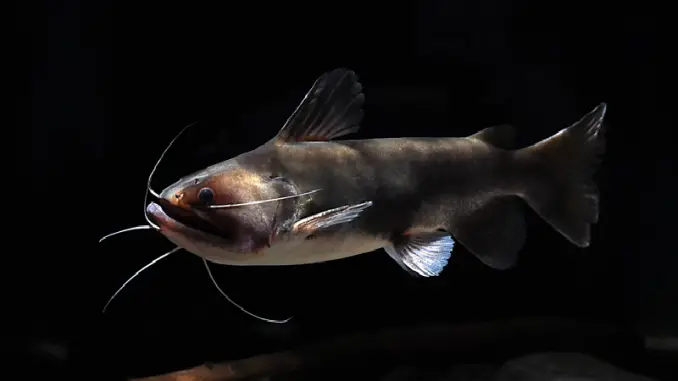
Gulper Catfish is an appealing aquarium fish that is almost like a catfish throwback to an earlier time. Its classic catfish appearance and large smooth body grab your attention.
Gulper Catfish are predatory fish, and it is fun to watch them devour (or gulp) their prey. I also like to look at their smooth, distended bodies after they have finished a meal.
If feeding live fish to your aquarium pet is not your jam, you might not be ready for or inclined to the Gulper Catfish. But if you like a nocturnal creature than you can watch wandering the tank for yummy eats, the Gulper might be just the addition to your aquarium.
In order to keep these predatory catfish, you will need a decent amount of space, as they need a larger 100-gallon tank in order to not feel cramped.
In this article, I’ll discuss everything you need to know about keeping these fish happy, healthy, and well, full. I’ll explore their origins, behavior, appearance, tank needs, and dietary behaviors so that if you decide you want to have a pet Gulper Catfish, you will be ready to accommodate one.
TABLE OF CONTENTS
Gulper Catfish Facts & Overview
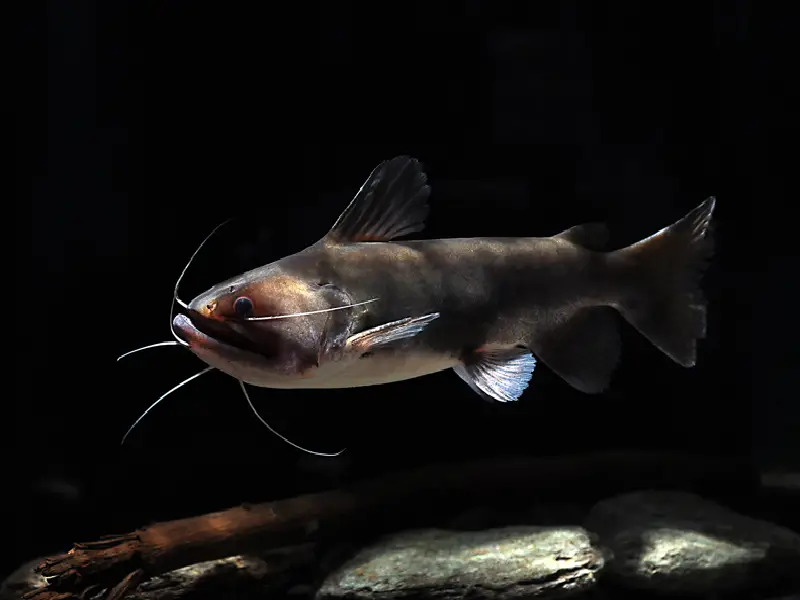
| Category | Rating |
| Care Level: | Easy |
| Temperament: | Predatory |
| Color Form: | Grey, black, brown, orange |
| Lifespan: | 4-5 years |
| Size: | 10 inches |
| Diet: | Carnivore |
| Family: | Auchenipteridae |
| Minimum Tank Size: | 100 gallons |
| Tank Set-Up: | Freshwater with wood and decorations |
| Compatibility: | Limited compatibility due to aggression |
Also known as the Ogre Catfish, the Gulper Catfish is native to southern Central America and South America. They are often found in southern South America in Argentina. They live in the basins of the Rio Negro and Rio Orinoco. They are accustomed to slow-moving water and submerged structure.
They can, however, handle stronger currents due to their size and girth, and that is what you will want to provide in your home aquarium, as the stronger filter will help keep the finite tank size clear of ammonia, nitrites, and nitrates.
Providing wood and decorations strategically placed in front of the filter intake will help reduce the amount of flow in the tank, and create a current that is amenable for the Gulper Catfish.
Typical Behavior
The biggest behavioral mention is the Gulper Catfish’s insatiable predatory nature. You’ll see them coming out at night, wandering the tank looking for food.
The average lifespan of Gulper Catfish is anywhere from 8 to 15 years, although I have heard of fish keepers reporting that their Gulper Catfish lived for 20 years. It seems more likely that this longer life expectancy would more likely be in the wild.
In addition to its predatory nature with other fish, Gulper Catfish are also aggressive with other Gulper Catfish and other catfish in general. Therefore, I don’t recommend keeping them in a tank with other catfish.
I should mention that the more generous the size of the tank is, the less likely acts of territorialism and aggression will be.
Appearance
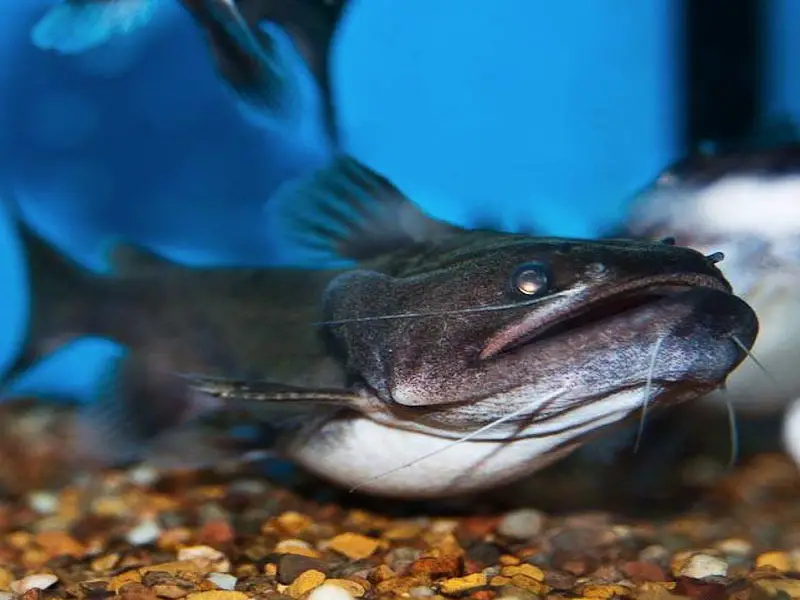
Gulper Catfish are classic-looking catfish, complete with the downturned mouth and whiskers.
This particular species appears in a range of colors, from light brown to orange to black, with a white belly that appears distended after meals. Their skin is soft and velvety, and they have barbels that they use to find their way around since they have terrible eyesight.
Attaining an average size of 10 inches (25.4 cm), Gulper Catfish is not the largest of the catfish, but they are decent-sized. Compared to their overall size, Gulper Catfish have relatively small fins. On the top of their bodies, they have a dorsal and adipose fin, and they also have two smaller pectoral fins, a broader caudal fin, two pelvic fins, and one anal fin.
Try not to make contact with the pectoral and dorsal fins or you’ll likely get punctured by the sharp rays on these fins. Be careful when you are buying a Gulper Catfish as some sellers will clip the sharp rays so that they don’t puncture the bag that Gulper Catfish is being stored in, which could actually lead to an infection.
If you see signs of infection, be careful that you avoid medication with copper, which can be toxic to the Gulper Catfish, which has no scales.
Gulper Catfish also have three pairs of barbels to help them navigate their surroundings.
Habitat and Tank Conditions
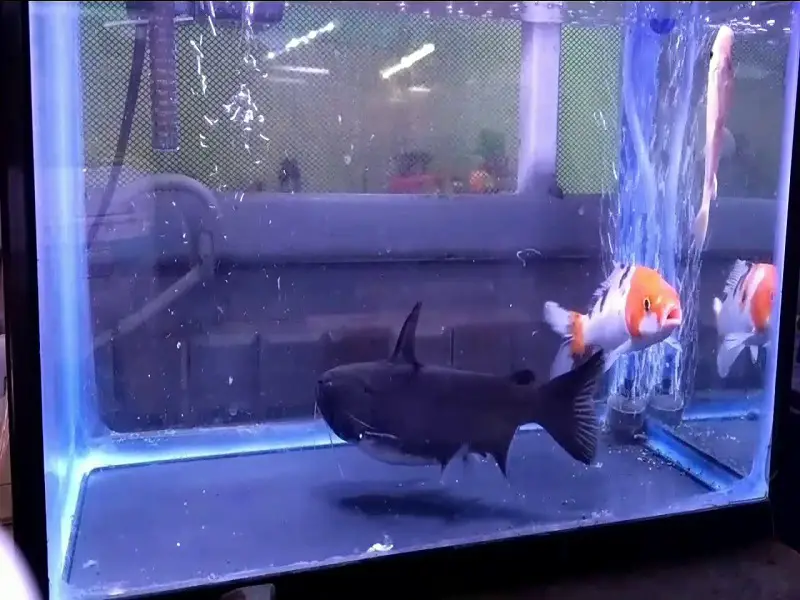
Gulper Catfish need moderately large tanks in order to grow to their fullest potential, have enough swimming room, and not be crowded.
In their natural habitat in Central and South America, Gulper Catfish are used to slow-moving waters with an abundance of wood, so they will appreciate an aquascape with driftwood of any type. Make sure the wood pieces are chunky and not sharp.
Pro tip: Don’t forget to quarantine any driftwood or decorations before adding them to the tank. Wood, plants, and decorations can be carriers of parasites and disease and can put all your aquarium inhabitants at risk.
Gulper Catfish have no scales, so you want to make sure to use soft sand or soft pebble substrate. Their underbellies are particularly soft and could be damaged if they rub against a rough substrate.
Gulper Catfish also need a cave or overhang to escape the light and activity during daytime hours. You could take an unfinished planter pot and turn it on its side in the tank, burying enough of it to anchor it. That would be enough to keep the Gulper Catfish content.
Speaking of caves, Gulper Catfish will appreciate dim lighting, since they are nocturnal creatures. The dim light is also reminiscent of their habitat in the wild.
Water Conditions
Gulper Catfish can handle varying water quality; however, as large predators, they do produce an enormous amount of waste, so it’s a good idea to keep the tank clean. In addition, any tank mates that you have paired them with may have more strict water quality needs.
When you test the water parameters, make sure to check for ammonia, nitrite, and nitrate levels, which can be harmful to all aquarium inhabitants. A good filter will also help keep the tank clean and improve oxygen levels.
The optimal parameters to ensure a close match to their natural habitat are:
- pH levels: 5.6 to 6.8
- Water hardness: soft and acidic
- Water temperature: 75°F to 84°F (24-29°C)
What Size Aquarium Do They Need?
Although some hobbyists maintain that a 40-gallon tank is sufficient for Gulper Catfish, I recommend a 100-gallon tank. Although they are not the largest catfish, at 10 inches (25.4 cm), they need space to grow and space to swim. Cramming them into a tank that is too small will cause undue stress and could even shorten their lifespan.
In addition to the total volume, fish this large need a tank that is long enough to accommodate their swimming needs, so the aquarium should be about 72 inches long.
Tank Mates
Choosing proper tank mates for the very hungry, large-mouthed Gulper Catfish can be challenging. These fish can eat a fish that is half the size of its own body. But that doesn’t mean they won’t try to eat a fish that is the same size, and that won’t turn out well for either fish.
I recommend sticking to a tank mate that is at least 3 or 4 inches larger than the Gulper Catfish.
In addition to finding larger tank mates, you also need to stay away from fish that are aggressive and nip. Gulper Catfish have fins and barbels that are susceptible to injury around territorial fish. Since they enjoy exploring the aquarium, they are at risk for injury and stress when they are surrounded by aggressive fish.
Gulper Catfish are nocturnal, so you could choose fish that are more active during the day when Gulper Catfish are busy staying out of sight.
Suitable Tankmates
Keeping Gulper Catfish Together
Catfish are notorious for their aggression towards their own species, so it is better to keep Gulper Catfish as singles. They will get very territorial with other Gulper Catfish or other plecos.
Care
One of the best gifts you can give your Gulper Catfish is the gift of frequent water changes. Predatory fish and large fish produce an awesome amount of waste, and Gulper Catfish are both large and predatory.
Dirty water increases levels of ammonia and nitrates, which puts the health of your Gulper Catfish at risk, as well as any other aquarium inhabitants. Gulper Catfish are pretty hardy, but you want to be careful that you maintain consistency in water temperature and parameters when you change out the water.
Gulper Catfish don’t do well when their conditions are abruptly changed. If you don’t test the water that you are changing out, you could risk the health of your Gulper Catfish with the shock of the change, and even shorten their lifespan.
In the end, poor water quality and stress increase the risk of your Gulper Catfish catching parasitic, bacterial, and fungal diseases that can be harmful or fatal.
Diet
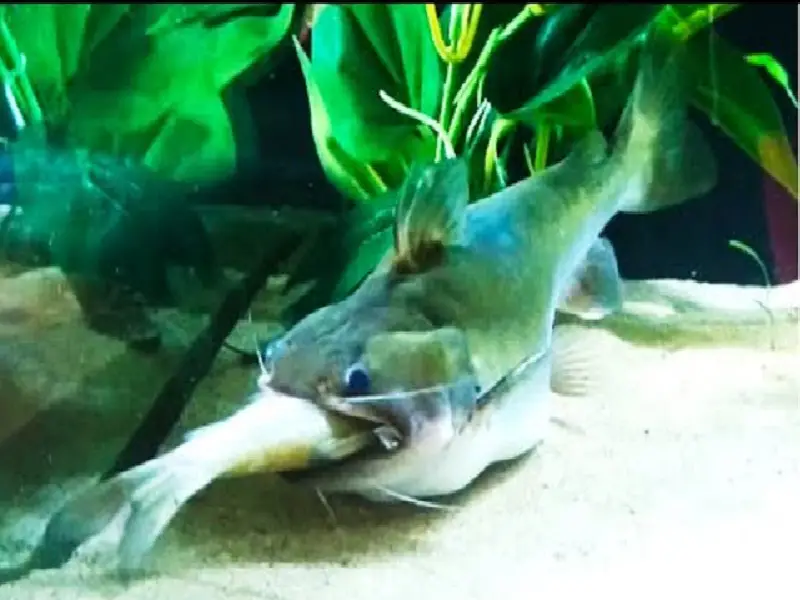
Gulper Catfish are carnivores, so you will need to employ feeder fish to provide them with proper nutrition. These catfish won’t willingly eat vegetables, so you’ll have to hide them in the feeder fish, a process known as gut loading. In gut loading, you feed flakes or pellets to the feeder fish and then feed the feeder fish to the Catfish Gulper within an hour.
You don’t want to give the feeder fish time to fully digest the vegetables, for it would rob the Catfish Gulper of the nutritional benefits. Goldfish and Minnows, both common feeder fish, have fast metabolisms, so it’s important to feed their full bellies to the Catfish Gulpers.
Pro tip: It is not uncommon for feeder fish to carry parasites and other diseases, so as with all tank additions, you need to quarantine them before offering them to your Gulper Catfish. That means you will need a separate tank for holding feeder fish.
When you put them in quarantine, you should treat them for parasites. After a period of 30 days, you can then offer the feeder fish to your Gulper Catfish.
Another option would be to breed and raise your own minnows or goldfish to use as feeder fish. This practice would allow you to be certain that you are offering your Gulper Catfish the highest quality food that is free of disease.
In addition to feeder fish, you can add variety to the Gulper Catfish’s diet with whole seafood offerings, such as clams, chunked fish flesh, shrimp, and squid. Now there are even special catfish feeds available that hobbyists can purchase.
You may have difficulty getting your Gulper Catfish to accept prepared foods as described above. Many hobbyists enjoy hand-feeding their Gulper Catfish, so you can train them to take the food. Try offering them frozen silversides and shrimp to get them accustomed to eating prepared foods.
Breeding
There are no reports of successful breeding of Gulper Catfish in home aquariums. I do not recommend trying to breed Gulpers on your own.
Are Gulper Catfish Suitable for your Aquarium?
Some aquarists find Gulper Catfish to be captivating in appearance while others think they have a face only a mother could love. The semi-large fish is definitely 100% catfish. Every typical catfish quality that you can think of is present in Gulper catfish.
True carnivores, Gulper Catfish need specific tank mates; they need to be protected from some fish and you’ll need to protect other fish from them. Any aquarium hobbyist who wishes to keep a Gulper Catfish should be prepared for regular water changes, as large fish result in a lot of waste, so it will take more work to keep your tank clean.
You’ll also have to be ready for the challenges of keeping a predatory fish and all that entails. But if you’re willing and you have enough room for a large-sized aquarium, Gulper Catfish is pretty special, so why not give them a try?
Are Gulper Catfish a great aquarium fish or a species you’d choose to avoid? Leave your opinion in the comments below.
FAQ
Why won’t my Gulper Catfish eat veggie flakes or pellets?
Feeding Gulper Catfish vegetables is not a lot different than feeding small children vegetables–you have to hide them. In the case of the Gulper Catfish, you have to hide these nutrients within the belly of their lunch: feeder fish.
You have to feed flakes or pellets to the feeder fish, and then after the feeder fish have partially digested it, feed the fish to the Gulper Catfish. This process is known as gut loading.
There are some flakes and pellets made today that are more palatable to Gulper Catfish, so you might be able to get him to eat that if you try a few times.
Do I need to have a separate breeding tank?
As there have been no reports of successful breeding of Gulper Catfish in captivity, I do not recommend breeding at home, with or without a separate tank.
What is the average lifespan for Gulper Catfish?
Gulper Catfish have an average lifespan of 8 to 15 years in captivity.
How big is Gulper Catfish?
The average size of Gulper Catfish in captivity is 10 inches (25.4 cm), although you will see some a little smaller (8 inches or 20.3 cm) and some a little larger (12 inches or 30.5 cm). In the wild, Gulper Catfish can be even larger.

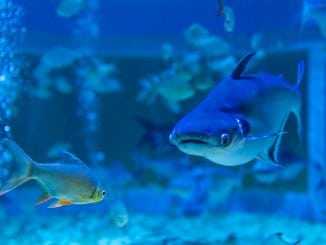
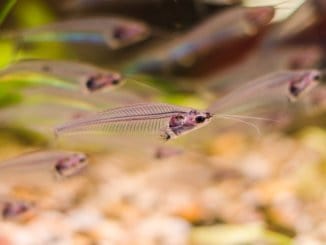
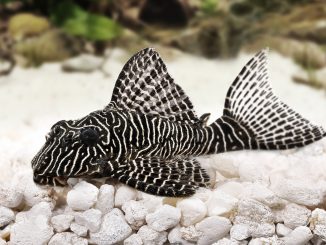
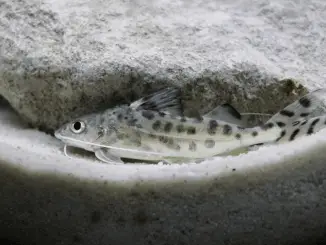
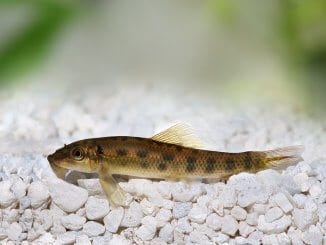
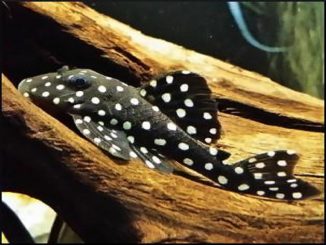
Be the first to comment